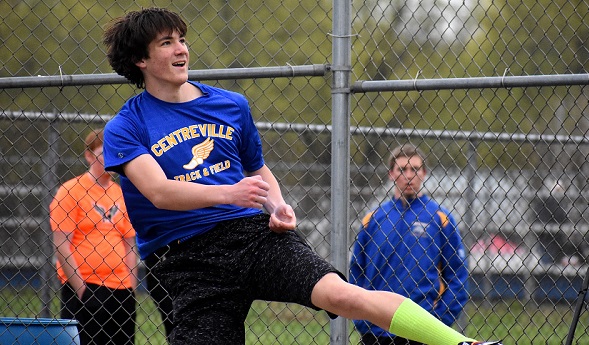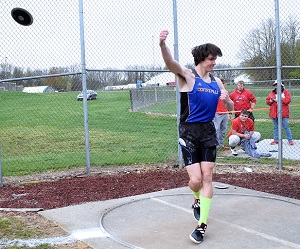
Self-Taught Overholt Firing Record Tosses
By
Wes Morgan
Special for MHSAA.com
May 10, 2019
We’re all students at YouTube University now, with information — some useful — accessible from experts around the globe. Trending this week are videos ranging from Gordon Ramsay’s breakfast tacos tutorial to step-by-step guides for picking locks with hairpins.
 Centreville senior Tyler Overholt made better use of his online browsing time, eventually stumbling upon Poland’s two-time Olympic silver medalist in the discus, Piotr Malachowski. Though he doesn’t know it, Malachowski became Overholt’s coach.
Centreville senior Tyler Overholt made better use of his online browsing time, eventually stumbling upon Poland’s two-time Olympic silver medalist in the discus, Piotr Malachowski. Though he doesn’t know it, Malachowski became Overholt’s coach.
An immeasurable amount of determination, and countless hours of watching film of Malachowski, led Overholt to break a 42-year-old school record earlier this year — a mark he since has bettered twice. At the White Pigeon Invitational in April, Overholt registered a distance of 155 feet, 7 inches to surpass Trent Grossman on the Bulldogs’ record board. A week later, Overholt made a toss of 160-6 in a meet that wasn’t officially finished due to inclement weather. In the following meet, he recorded a throw of 158-1.
“Let me tell you, I don’t smile much, but I had a big smile on my face,” said the soft-spoken Overholt, who earned Division 4 all-state status with a seventh-place finish after posting a mark of 138-3 at last year’s MHSAA Finals. “I was jumping up and down.”
Centreville jumped up to Division 3 this year, but Overholt’s marks still make him one of the favorites a few weeks from now at this year’s Finals at Jenison High School. Yet, you probably wouldn’t assume that with just a passing glance.
As a lanky freshman, Overholt was encouraged to try something other than discus. Still lanky now at 6-foot-6, 192 pounds, Overholt doesn’t look like a prototypical thrower.
But his fascination with the event only grew. As a sophomore, he approached new head coach Mike Hunter about giving it a try. Hunter, like most coaches at smaller schools, does the most he can to instruct his athletes in a wide variety of events. But he’s honest about a lack of expertise in the discus.
“He worked hard at the discus basically by himself,” Hunter said of Overholt. “He did some research and found some people. The hard thing with track is it is hard to coach every event if you don’t understand it, so to speak. I never did field events. I’ve tried to do the best I could to help him, but he’s done a lot on his own.
 “He has just worked hard and has great technique. It’s not just arming the thing out there. He’s been great to coach, and he’ll do what you ask him to do. He’s right (in the state championship mix) if he can relax and throw with confidence.”
“He has just worked hard and has great technique. It’s not just arming the thing out there. He’s been great to coach, and he’ll do what you ask him to do. He’s right (in the state championship mix) if he can relax and throw with confidence.”
Overholt, who also took on the shot put and hurdles for the first time this spring, knew mastering the technique could trump strength. So he studied Malachowski and other high-level throwers, had his mother, Debra, record his meets, and he broke down that film as well.
“For the first year, I just searched a lot of Olympic discus throwers and tried to copy them,” he said. “Then I started applying details into the spin. There was a lot of improvement, especially my junior year.”
Gaining 20 pounds over the last year has factored in as well after Overholt begrudgingly followed Hunter’s advice to spend more time in the weight room.
“I wasn’t really into it at first,” Overholt said. “It took me until my senior year to really start lifting. Now I’m a lot stronger.”
And more confident and experienced. He admitted that his performance at the
Finals last year was far from his best as he wrestled with the nerves that often come into play for first-timers. Overholt entered this season with the school record in his crosshairs, and now that he’s crossed that off his list, he’s chasing 170 feet. As a result of his success in the circle, his future plans have been altered in the last week.
Instead of going into the Navy after graduation, Overholt is headed to Olivet College, where he’ll throw for the Comets. He still intends to enlist in the Navy when he’s done.
“Some people are amazed by what I do and want to know the secret,” he said. “I’ve surprised myself.”
 Wes Morgan has reported for the Kalamazoo Gazette, ESPN and ESPNChicago.com, 247Sports and Blue & Gold Illustrated over the last 12 years and is the publisher of JoeInsider.com. He can be reached at [email protected] with story ideas for Berrien, Cass, St. Joseph and Branch counties.
Wes Morgan has reported for the Kalamazoo Gazette, ESPN and ESPNChicago.com, 247Sports and Blue & Gold Illustrated over the last 12 years and is the publisher of JoeInsider.com. He can be reached at [email protected] with story ideas for Berrien, Cass, St. Joseph and Branch counties.
PHOTOS: (Top) Centreville’s Tyler Overholt watches one of his discus tosses soar. (Middle) Overholt unloads a toss during a meet this spring. (Photos courtesy of JoeInsider.com.)

Hastings Relays Reigns as State's Oldest Continuous Track & Field Meet
By
Steve Vedder
Special for MHSAA.com
April 10, 2024
Bob Branch remembers dabbling in other sports, but his first love was always running.
 The Hastings High School graduate admits he could never hit a baseball, football didn't especially appeal to him and basketball was just another way to spend time with friends. But for Branch, now 93, there was always track. That's the sport where his fondest and sharpest memories remain. And if you're talking track, many of his favorite memories come from participation in the state's oldest continuous track meet, the Hastings Relays.
The Hastings High School graduate admits he could never hit a baseball, football didn't especially appeal to him and basketball was just another way to spend time with friends. But for Branch, now 93, there was always track. That's the sport where his fondest and sharpest memories remain. And if you're talking track, many of his favorite memories come from participation in the state's oldest continuous track meet, the Hastings Relays.
Always held in early April, the meet dates back to 1937 – a bygone time that saw the first hostilities of World War II, gas at 20 cents a gallon and a loaf of bread selling for a dime.
And at a dusty old track surrounding the county fairgrounds in Hastings, a small relay event that included a scattering of participants from a dozen high schools was taking its first tentative steps.
Branch recalls a time when kids would run home after track practice because there were no buses, inexperienced young coaches had little actual knowledge of running fundamentals, and athletes looked at the sport as an afterthought after spending most of their high school days playing football and basketball.
 For Branch, the relays were the ideal way to ease into the track season.
For Branch, the relays were the ideal way to ease into the track season.
"I just liked to run," said Branch. "I remember I anchored a relay with my brother, and it always seemed cold when we had that meet. I remember teams would come from all over and you saw a lot of good athletes. Everybody seemed to have someone who was really good. Track wasn't very popular at that time, but I have a lot of good memories from running."
The Hastings Relays, which has changed formats and even names during its nearly nine-decade history, would traditionally kick off the track season. The meet was originally held at a makeshift quarter-mile track which surrounded the town's fairgrounds and was part of the city's annual Hastings Carnival – the track would become the midway during fair time.
The meet eventually moved to Johnson Field when the football field was dedicated in 1949 and ballooned to as many as 50 teams at its peak in 1957. For more than seven decades it was known as the Hastings Relays and then the Hastings Co-Ed relays before becoming the current Hastings Invitational, with the latest edition scheduled for Friday.
Johnson Field had a cinder track before it became an all-weather surface in the 1980s. During a time long before computers would be used to organize meet heats in mere minutes, Hastings coaches of all sports – defined as "volunteers" by the athletic department – would meet on the Friday before competition to hash out events.
People associated with the meet still recall the camaraderie built on those long Friday nights, followed by working what would often become 10-hour meets. Steve Hoke has been involved since watching his father, Jack, who coached teams at 15 of the meets beginning in 1951 and also had run in the first Hastings Relays. Steve Hoke later competed in the Relays as well during the early 1970s before becoming an assistant track coach, later the Hastings athletic director and now a volunteer worker.
"It was always a huge deal," said Hoke, who said the meet began as a pure relay event before transitioning to its current team format in the 1990s. "I remember we'd line the track the night before, and all the coaches would come to the house to organize everything. There was a brotherhood.”
 If you quiz many of the fleet of volunteers who've worked the relays over the years, each has a different memory from the meet. While Hoke describes the brotherhood and Branch the outstanding competition, others remember weather and the time a thunderstorm wiped out the line markings on the cinder track, or waking up to find three inches of snow that caused a rare cancellation of the meet. Others recall the shock of moving from the cinder to all-weather track or using the meet as an early measuring stick of what it would take to qualify for the state meet. The real old-timers remember the meet disappearing for three years during World War II.
If you quiz many of the fleet of volunteers who've worked the relays over the years, each has a different memory from the meet. While Hoke describes the brotherhood and Branch the outstanding competition, others remember weather and the time a thunderstorm wiped out the line markings on the cinder track, or waking up to find three inches of snow that caused a rare cancellation of the meet. Others recall the shock of moving from the cinder to all-weather track or using the meet as an early measuring stick of what it would take to qualify for the state meet. The real old-timers remember the meet disappearing for three years during World War II.
Hastings native and Western Michigan grad Tom Duits was the state’s second collegian to break the four-minute mile when he ran a 3:59.2 at a meet in Philadelphia in 1978. Duits, who ran in three Hastings Relays, was in line to join the U.S. Olympic team in 1980 before the United States pulled out of the games due to tension with Russia.
Duits has his own memories of the meet and the competition he faced there.
"I remember sunshine and being excited to be competing again. There were all these athletes swarming around; it was an awesome display of talent," he said. "It was always one of the best meets we'd be in. You could pretty much see the level of runners who would be at state, which made it a big deal. It was always early, but you could tell where you stood. It was great exposure."
Hastings track star Wayne Oom competed in four Hastings Relays from 1984-87. One of his sharpest memories was the difference between running on a raw cinder track versus the far more comfortable all-weather surface.
"Those cinders would grind into your skin," said Oom, part of the Hastings school record in the two-mile relay. "But I think it helped us because when we'd go to other tracks, it seemed we would run faster. I remember how competitive it was, especially in the distances. There were some great runners."
While participants have their unique memories, so do coaches. Former Saxons coach Paul Fulmer remembers 2008 when his team finished first on the boys side of the meet while his wife, Grand Haven coach Katie Kowalczyk-Fulmer, saw her girls team win the championship.
 "I knew we were one of the favorites to win because we were usually near the top of our conference and Regional," he said. "But then Katie's team was pretty good, and it was cool for them to win too."
"I knew we were one of the favorites to win because we were usually near the top of our conference and Regional," he said. "But then Katie's team was pretty good, and it was cool for them to win too."
Fulmer, who coached Hastings from 1978-81 and then 1985-2010, said at least part of the meet's popularity was derived from a unique way of scoring. Instead of individuals earning points solo, participants worked in pairs. For instance, two athletes would combine their shot put or long jump scores. New events such as the 1,500 relay and sprint medley were added.
"We had a tradition of being the state's oldest meet, and that was a big deal," Fulmer said. "And we ran a good relay; that attracted teams too. We took a lot of pride in that.
"And we'd get quite a lot of people to come to the meet. We'd set up until like 9 or 10 p.m., and then we'd have a party with all the coaches on Friday night."
While the meet has stretched 87 years, Branch said early participants and current runners have one thing in common: a drive to win. Branch ran in an era when the popularity of high school track was in its infancy. Today some of the best all-around athletes at a school are involved in the track program. The relays span the nearly nine decades in between.
"The quality of teams has gotten better and better," said Branch, the 1947 Lower Peninsula Class B Finals champ in the 220. "And this has made for a better meet. We would get guys who played football or baseball kind of drift into track, and that made the sport better. I think people began to appreciate track because we'd get teams from all over.
"We went from not really knowing what we were doing to track being a good sport. Even then, I'm not sure we appreciated what we had. We really liked the Hastings Relays and always wanted to do well there. It became popular and quite an honor to do well. Those are the kind of things I remember."
PHOTOS (Top) Racers run at the Hastings Relays, with several more awaiting their turns to compete at the longtime meet. (2) The author wrote on the 50th anniversary of the Relays for the Hastings Banner nearly 40 years ago. (3) Past athlete, coach and athletic director Steve Hoke shows some of the Relays awards from the 1930s. (4) Tom Duits was one of the state’s biggest track stars of the 1970s and ran in three Hastings Relays. (Top photo by Dan Goggins, Hoke photo provided by Steve Hoke and Duits photos provided by Tom Duits.)

